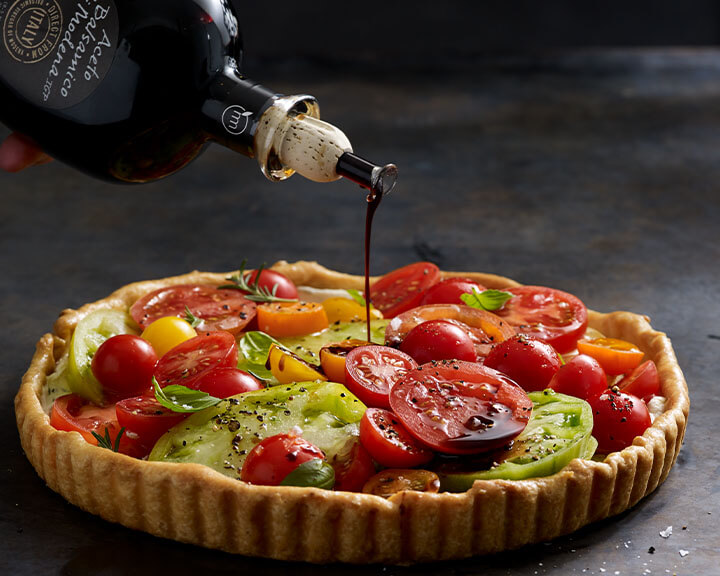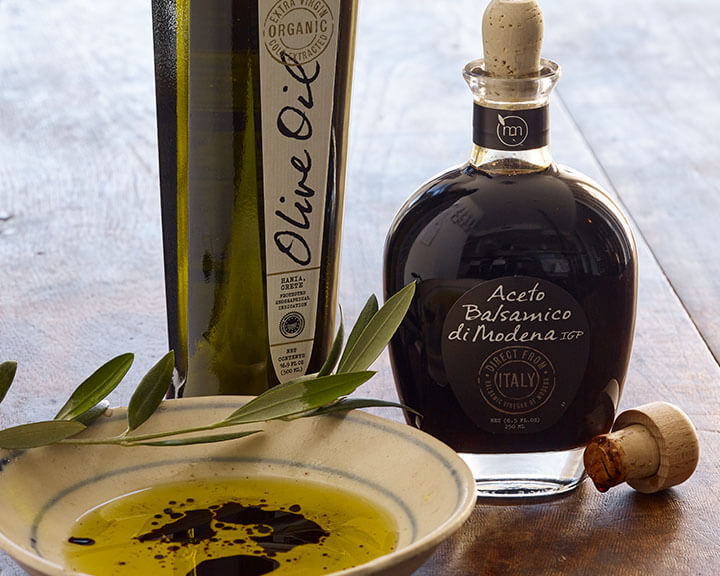
Balsamic vinegar: It’s a highly nuanced elixir that’s unlike any other condiment in the world. Even calling it a condiment feels wrong, somehow.
At its most basic, balsamic vinegar is made by reducing grape must (a juice made from the fruit’s skins, seeds, and stems) and aging the blend in wooden barrels. It was first made and perfected in northern Italy, specifically in the Modena and Reggio Emilia regions, where it continues to reign supreme today.
So why do some cost $5 a bottle…and others upward of $100 an ounce?
Like many things, it comes down to how it was made and the quality of ingredients. The coveted traditional ones are rich, velvety, and deliciously sticky with flavor notes of cherry, fig, molasses, and even chocolate. They boast a profoundly balanced sweet-to-tart ratio with a low level of acidity that’s begging to be paired with, well, everything! It transcends salad dressings and beautifully complements fruits, fragrant cheeses, and even ice cream.

Here are five things to know about everyone’s favorite drizzle:
1. Grades
All balsamic vinegars fit into one of these three categories:
D.O.P. or Denominazione d' Origine Protetta (Protected Designation of Origin): Made in Modena or Reggio Emilia and aged at least twelve years. Also referred to as aceto balsamico tradizionale. These are going to be your pricier bottles and have a thick, viscous texture.
I.G.P. or Indicazione Geografica Protetta (Indication of Geographic Protection): Made in Modena or Reggio Emilia, but aged for less than twelve years. Also called aceto balsamico. Still high in quality, but a bit kinder to your wallet. You can find our own Metropolitan Market balsamic among this group.
Condimento: Literally everything else. Do your homework on these—there are some phenomenal balsamic vinegars at this level, but there can also be cheaper ones with additives and/or artificial sweeteners. Read the label. Grape must and wine vinegar should be the only things on there. To achieve the sweet flavor and syrupy consistency of aged balsamic, bring to a boil, simmer on low, and reduce.
2. Label Color
D.O.P. balsamic vinegar will have one of three aging labels: red means it’s been aged 12 years, silver means 18, and gold means it’s been aged 25 years.
3. Balsamic barrels are alive
Balsamic barrels are purposefully kept in places with exposure to the elements, like attics. They expand and contract over time as the wood fluctuates with the changing seasons and temperatures. That movement allows the vinegar to soak up the flavors of the wood and better develop its sugars.
4. Brandy and balsamic vinegar start with the same grape
Lambrusco and Trebbiano are two of the most common grapes used in balsamic vinegar. We don’t hear a lot about Trebbiano, but it’s actually one of the most widely-grown grapes in the world, and it’s a staple in both balsamic and brandy production.
5. It can take the heat, but you don’t want it to
High-quality, aged balsamic vinegar will break down under prolonged heat and lose some of its famed flavor. Add it to your cooking in the last few minutes or right before serving. Recipes that call for balsamic to be used in cooking usually refer to the non-aged varieties.
